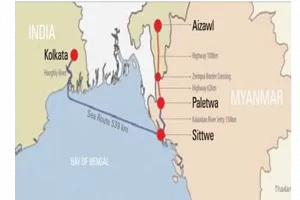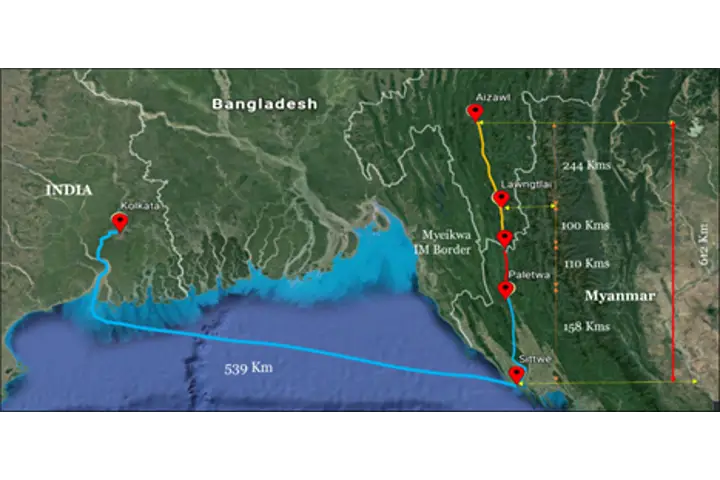After the inauguration of the much-awaited Sittwe Port in Myanmar, the Indian Railways has now announced linking the neighbouring country with Mizoram. It has approved the final location survey of a 223 km rail line from Aizawl to Hbichhuah in Mizoram, near the Myanmar border. Sources said that landlocked Nepal and Bhutan could also benefit once the project is complete.
The new railway line will channel into the ambitious Kaladan Multi-Modal Transit Transport Project (KMTTP), jointly identified by India and Myanmar.
The KMTTP, has been conceived with the purpose to connect landlocked northeast with the port of Sittwe in Myanmar, and reduce its dependence on Kolkata. The port, at the mouth of the Kaladan river, flows into Mizoram from the Chin state in Myanmar. Finally, it merges into the Bay of Bengal.
The idea is to leverage the 1,623 km India-Myanmar land border and their 725-km maritime boundary in the Bay of Bengal, in a bid to reach out to ASEAN.
Being the only country that sits at the intersection of India’s “Neighbourhood First” policy and its “Act East” policy, Myanmar is an essential element in India’s practice of regional diplomacy in the Indo-Pacific, and serves as a land bridge to connect South Asia and Southeast Asia, the Diplomat in a report said earlier.
The Kaladan project
As part of the mega KMTTP, Sittwe will then be connected with Paletwa, the westernmost town of Myanmar, through the inland waterways on the Kaladan river. Paletwa will further be connected via a 62 km road with Zorinpui in Mizoram. As per plan a 110 km road is also being constructed between Zorinpur and Aizawl. That apart, the rail network is being pushed as well. The just-announced initiative of the Indian Railways is part of this overall network.
The larger plan is to connect Sittwe with Kyaukhtu in Myanmar’s Chin region. Both India and Myanmar have also discussed linking Kyaukhtu with Zironpui in Mizoram. An integrated check post is already operating in Zironpui.

Why is the project important
The Kaladan project will have a major geopolitical dimension as it gives India an opportunity to offset China’s Belt and Road Initiative. Since Myanmar is India’s gateway to the ASEAN via the northeastern states, New Delhi has also added another spur to Naypyidaw through Manipur.
Sarbananda Sonowal, Minister of Ports, Shipping and Waterways said that once fully operationalised, KMTTP will provide alternate connectivity from the eastern coast of India to the northeastern states through the Sittwe port. “This is a far more feasible route for the trade and commerce of Northeast India, than the existing route via Siliguri to Kolkata, saving time, money and excelling efficiency,” he said, while inaugurating the Sittwe port in May, this year.
Potentially, the KMTTP could become part of a larger connectivity initiative within the BIMSTEC (the Bay of Bengal Initiative for Multi-Sectoral Technical and Economic Cooperation) and the Bangladesh-Bhutan-India-Nepal (BBIN) framework.
BIMSTEC has seven member countries–five from South Asia which include India, Bangladesh, Bhutan, Nepal, and Sri Lanka besides Myanmar and Thailand in Southeast Asia. The BBIN – another sub-regional initiative aimed at boosting connectivity through road and rail networks among the South Asian region is also underway.
With the aim to facilitate seamless flow of movement of passenger and cargo vehicular traffic among the BBIN member countries, the BBIN Motor Vehicles Agreement (MVA) was signed in 2015, after Pakistan objected to a Saarc (South Asian Association for Regional Cooperation) Motor Vehicle Agreement—essentially an economic corridor. While the BBIN initiative started off as a road project, it is now being extended to waterways as well.
As part of the overall connectivity strategy in the region, at a later stage Nepal could be also given access to Sittwe port.
Additionally, the India-Myanmar-Thailand Trilateral at the heart of the BIMSTEC initiative is also coming up. Recently, Union Minister Nitin Gadkari said that work on the trilateral Highway is 70 per cent complete.
Though there have been delays in the execution of these projects, work has now picked up with regular monitoring by top authorities. The trilateral highway is expected to be finally extended to Da Nang in Vietnam and Laos.
Amid the BIMSTEC free trade agreement proposal, the multiple connectivity projects crisscrossing through almost all the member countries barring Sri Lanka are expected to have ground breaking impact enhancing the economy of the region while easing movement of people.
Also read: Modi says BIMSTEC unity is a must to stem global turmoil




















